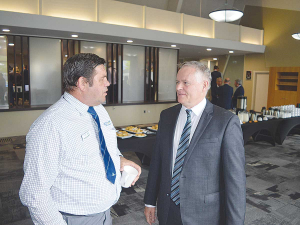Fonterra slashes forecast milk price, again
Fonterra has slashed another 50c off its milk price forecast as global milk flows shows no sign of easing.
 Fonterra chairman Peter McBride with Whakatane farmer Gerard van Beek at the co-op's annual meeting in November.
Fonterra chairman Peter McBride with Whakatane farmer Gerard van Beek at the co-op's annual meeting in November.
Nearly ten years after Fonterra’s last capital structure review, farmer shareholders have again started deliberating on the future shape of their co-operative.
An online survey, sent out last week by new chairman Peter McBride, signalled the start of the farmer consultation process.
The survey, with nine main questions, is to gauge the mood of farmers. The first question is how farmers feel about a potential change to the co-op’s capital structure.
Last week’s email, with the online survey, to farmer shareholders from McBride is the first opportunity for the 10,000 Fonterra shareholders to engage in the process.
The co-op’s board and management have been discussing potential capital structure changes behind closed doors for the past few months.
McBride says the board has been leading a review of its capital structure “to ensure it best supports our strategy and long-term vision for our co-op”.
“We have spent the past few months reviewing potential options, including staying with our current structure.
“Every option has its own merits, but also involves some form of trade-off.”
He says the board is seeking feedback on “the structural principles” that are most important to farmers.
After the farmer survey, the board will further develop options and continue consultations. A preferred option will then emerge and put before shareholders for further consultation before a vote.
Fonterra’s last capital structure review ran into trouble when a plan for a partial public listing was rejected by farmers, who feared they would lose control.
Following another round of consultations, Fonterra farmers agreed in 2012 to set up Trading Among Farmers (TAF), which allows outside investors to buy units and qualify for dividends. But these investors have no ownership or voting rights in the co-op.
Meanwhile McBride has also outlined the board’s other priorities for 2021. These include continuing to navigate the challenges presented by Covid-19 and delivering a strong milk price and forecast earnings.
“We are also focused on implementing our strategy, while clearly defining our longer-term strategic aspirations, and completing our portfolio review work through the asset divestment processes we have previously announced,” he says.
Fonterra is forecasting a milk payout of $6.70 to $7.30/kgMS following a strong rise in products sold by the co-op on Global Dairy Trade (GDT) platform.
Last month Fonterra chief executive Miles Hurrell said New Zealand dairy farmers deserve credit for premium prices fetched around the world for their milk.
He says New Zealand butter and skim milk powder are attracting premiums of $500/tonne more than European products right now and it’s all down to the sustainability credential of NZ milk.
“Our pasture-based systems, our high standards on animal welfare and our sustainability stories are starting to be recognised around the world,” Hurrell said.
Dairy prices have jumped in the overnight Global Dairy Trade (GDT) auction, breaking a five-month negative streak.
Alliance Group chief executive Willie Wiese is leaving the company after three years in the role.
A booklet produced in 2025 by the Rotoiti 15 trust, Department of Conservation and Scion – now part of the Bioeconomy Science Institute – aims to help people identify insect pests and diseases.
A Taranaki farmer and livestock agent who illegally swapped NAIT tags from cows infected with a bovine disease in an attempt to sell the cows has been fined $15,000.
Bill and Michelle Burgess had an eye-opening realisation when they produced the same with fewer cows.
It was love that first led Leah Prankerd to dairying. Decades later, it's her passion for the industry keeping her there, supporting, and inspiring farmers across the region.
President Donald Trump’s decision to impose tariffs on imports into the US is doing good things for global trade, according…
Seen a giant cheese roll rolling along Southland’s roads?